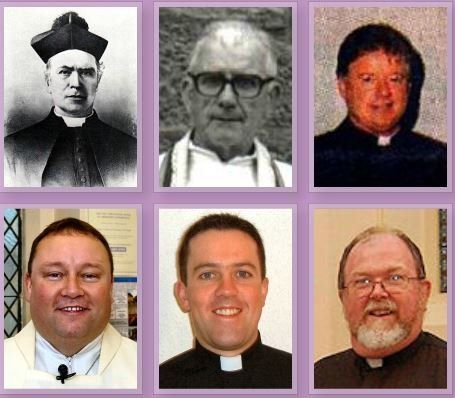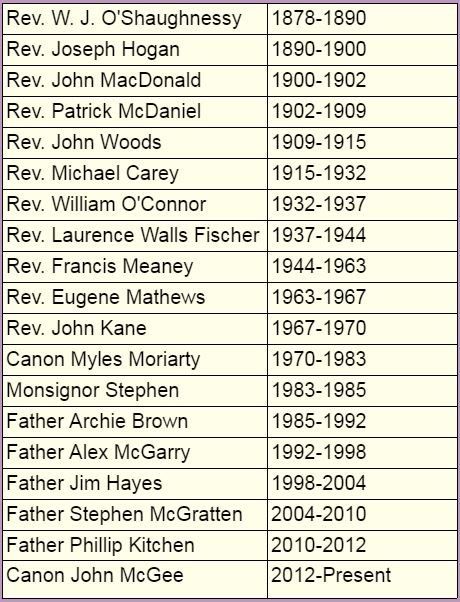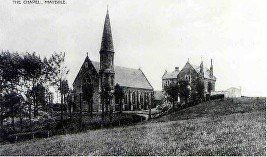Our Lady & St Cuthbert, Maybole - Parish History
Church Building History: Maybole, Carrick's Capital
by James T. Gray - Chapter 12, page 123.
The Roman Catholic Church at Allan’s Hill was built in 1878 and has the most commanding site of any of the church buildings in the town, being well
situated on the crown of a small hill and, although small, its site makes it look quite imposing.
It has an attractive steeple at the side of the front gable which has a rather fine window in it. Its interior is enhanced with an arch round the altar which is placed in a vaulted recess and the roof is supported by arches which have heads carved on the springers. Local tradition has it that these heads were carved by an old tramp mason who turned up one day during the building of the church and asked for employment in hewing the stones. He proved to be so expert he was given the job of carving the heads to the arches and it is believed he modelled his carvings on the heads of some of his fellow workmen and carved one in his own image. These heads were originally painted in life like colours as to hair, lips, eyes, etc., but early this century they were all painted a uniform fawn colour much to their detriment and it is to be hoped that someday they will be repainted in their original colouring.
Extract from the Scottish Catholic Directory of 1880
Maybole – In March, 1874, a site on an eminence to the south of Maybole was obtained for the erection of a church from Sir James Ferguson, of Kilkerren. In April, 1876, excavations were begun and the slopes of the hill were laid out in terraces. On the 4th of the following July the foundation stone was laid by Capt. Kennedy, of Craig, acting as proxy for Capt. D. Hunter Blair, of Dunskey, whose noble benefactions to religion in this Mission will be long remembered by the Catholics of Girvan and Maybole. The first Mass was celebrated in the Church on Christmas day, 1877; and on the 17th June, 1878, it was solemnly opened by the Bishop of Galloway, assisted by more than 20 Priests. This was the Bishop’s first public official act after his appointment to the See of Galloway. Capt. Hunter Blair having subsequently advanced funds sufficient to clear off the existing debt, and to complete the church according to the original plan, the works were recommenced and brought to a happy termination last November.
The cost, amounting to £3000, was defrayed by this generous benefactor, with the exception of two liberal donations from the Countess of Newburgh and the Marquis of Bute, and of a hundred pounds collected by the incumbent. The church is closely modelled upon that of the Benedictine Monastery of Crossraguel, the picturesque ruins of which are in the immediate vicinity. It consists of a nave 66 feet long by 26 wide, ending in a semi-octagonal apse 15 feet deep. The nave is lit by 5 traceried windows, nearly exact reproductions of those in Crossraguel. They are each 11 feet by 4, and are filled with cinque-foiled tracery mullions. The large west window, 21 feet by 12, vies in design and workmanship with the best specimens of mediaeval tracery. The sanctuary has two single-light windows, filled with stained glass figures of Our Lady and St. Cuthbert, the Patrons of the church.
Three beautifully moulded stone arches separate the sanctuary from the nave, and rest on Peterhead polished granite pillars, each of which is one block 12 feet high. Above the central arch a scroll carries the words "Sanctus, Sanctus, Sanctus". The arch on the Gospel side leads to the future presbytery, and to a recess containing a "Pieta". The arch on the epistle side leads to the sacristy, and to a convenient and well arranged confessional. The height of the outer roof to the apex is 45 feet; and the inner is 35 feet high, and is plastered throughout in Gothic arching, and divided into six bays by finely moulded ribs of red pine, resting on as many stone corbels. The carving of the stone bosses and corbels is a notable and distinctive feature of the church, and has cost nearly £200.
The four capitals are exquisitely carved with emblems of the Eucharist. The bosses in the interior represent King David, St. Anne, St. Andrew, St Margaret, St. Patrick, St. Agnes, St. Aloysius, St. Elizabeth of Hungary, and 8 canonized founders of religious orders. On the exterior, the bosses consist of a series of sculptured representations of the late and present Popes; Cardinals Cullen, Manning, and Newman; the present Archbishops and Bishops of Scotland; Bishops Hay, Cameron, Scott, Gillis, Murdoch, Gray, and Lynch; Prior Vaughan, O.S.B., F Cuthbert Wood, O.S.F., and Rev. M. Condon; Rev. Messrs. O’Shaughnessy, Thomson (deceased), and Dixon, pastors of Maybole; and Capt. Hunter Blair, capt’ Kennedy, the Countess of Newburgh, and Madame l’Amirale Reynaud, of Brest.


